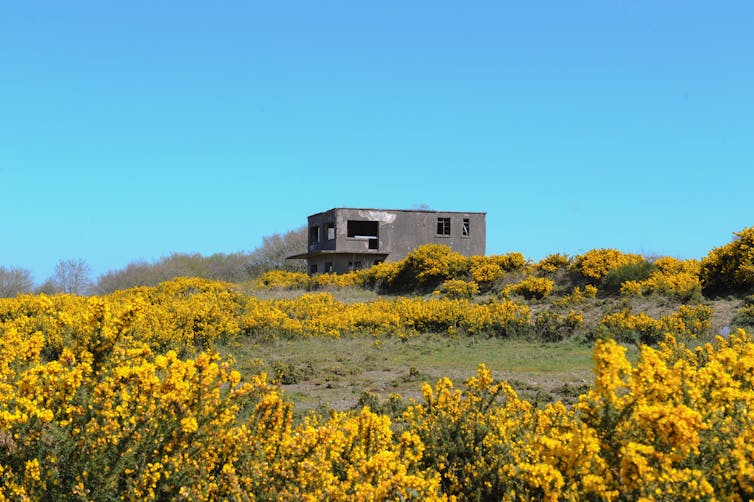From Charles Dickens to M.R. James, Christmas has a long association with ghost stories. In The Shepherd – part of Disney+’s festive fare for this year – we have an evocative addition to the genre.
Based on a short story by acclaimed thriller writer, Frederick Forsyth, and set in 1957, The Shepherd explores the links between flight and the spectral.
As Forsyth explained in the forward to a new edition of the story, it was written as a gift to his wife “in a single afternoon” on Christmas Eve 1974. It draws on his first-hand experiences as a Royal Air Force (RAF) National Service pilot during which he had flown the Vampire.
The film, which is largely true to Forsyth’s original, sees young RAF pilot Freddie (played by Ben Radcliffe) take-off on Christmas Eve from a British airfield deep in the German countryside bound for England. Freddie’s route should be straight-forward – a direct flight across the North Sea to the RAF base at Lakenheath, in Suffolk in east England.
Not long after he crosses the Dutch coast, however, he runs into problems – his compass fails and his radio malfunctions. With mere minutes of fuel left, salvation arrives. From out of the clouds comes an ageing Mosquito, a type of fighter-bomber from the second world war, and its pilot “shepherds” him home to a rather eerie and apparently deserted RAF base.
The Shepherd is a ghost story of a sort that became familiar in the post-second world war period. In this time, several storytellers found inspiration in the ghostly old airfields dotted around the UK. Many of these bases, once teaming with action and central to the war effort, had been left to decay – places full of ghosts and memories.
Abandoned airfields
The military airfields that were abandoned in the 1940s and 1950s were shaped by one of the most pivotal events of modern history: the second world war. Hundreds were hastily constructed throughout the country in what was one of the largest civil engineering projects in British history.
For a few short years, these bases were home to thousands of service men and women. They were places in which life was lived intensely, and which were also marked by tragedy, trauma and death. And then, with the victory of 1945, many became surplus to requirements. Abandoned, they were returned to farming and their buildings were left to moulder.
It’s not clear when the post-war cultural fascination with ghostly old airfields began, but two early examples are the films The Way to the Stars (1945) and Twelve O’Clock High (1949).
The Way to the Stars opens with scenes of an abandoned wartime airfield – the fictional RAF Halfpenny Field – before a flashback returns us to the dark days of 1940. Released in the US under the title Johnny in the Clouds, the film is a celebration of Anglo-American comradeship and common purpose.
Its opening sequence clearly inspired director Henry King as he set about filming Twelve O’Clock High. Starring Gregory Peck as a tough and experienced American air force officer “broken” by the strains of combat command, King’s film is set at another fictional wartime airfield in England, this time Archbury.
Just like The Way to the Stars, Twelve O’Clock High opens with scenes of an abandoned old airfield, lost to the weather and weeds. The runways are cracked and crumbling, the old buildings deserted and derelict. Into the scene walks an American airman who was stationed there during the war and through whose eyes we see the present fall away and the ghostly past return.
Haunted by history
By the time Forsyth was writing in 1974, the idea of the abandoned second world war airfield as a ghostly, memory-laden landscape had become firmly established.
Ghostly airfields are powerfully present, for instance, in publications like Airfields of the Eighth: Then and Now (1978) which provides an evocative photographic record of wartime airfields reclaimed by nature. Shots of the airfield “back then” are accompanied by those taken in the 1970s and the effect is suggestive of the lingering – if not ghostly – presence of the past.
Similar sentiment is apparent in the series of books written by Bruce Halpenny from the 1980s onwards. Called Ghost Stations, these volumes are full of spooky and spectral encounters among the ruined remains of airfields.

I even encountered stories like this when researching the visits to their old bases made in the 1970s and 1980s by many second world war veterans Allies in Memory. Stood on the balcony of an old control tower, or walking the concrete runways, more than one veteran experienced the past as a powerful and distinctly ghostly presence.
Indeed, during the dedication of the memorials established on many wartime airfields in the 1990s, this sense that the dead remained present was often remarked upon.
In the ghosts that many have encountered within such landscapes – as well as in evocative productions like The Way to the Stars, Twelve O’Clock High, and now The Shepherd – we can see the profound impact made by airfields on quiet corners of the rural landscape. These are places marked by the life and death of war, and in their ghosts we can see the long shadow of history.

Looking for something good? Cut through the noise with a carefully curated selection of the latest releases, live events and exhibitions, straight to your inbox every fortnight, on Fridays. Sign up here.
Sam Edwards has previously received funding from the ESRC, the US-UK Fulbright Commission, the US Army Military History Institute, and the US Naval War College. Sam is a Trustee of Sulgrave Manor (Northamptonshire) and of The American Library (Norwich).
This article was originally published on The Conversation. Read the original article.







